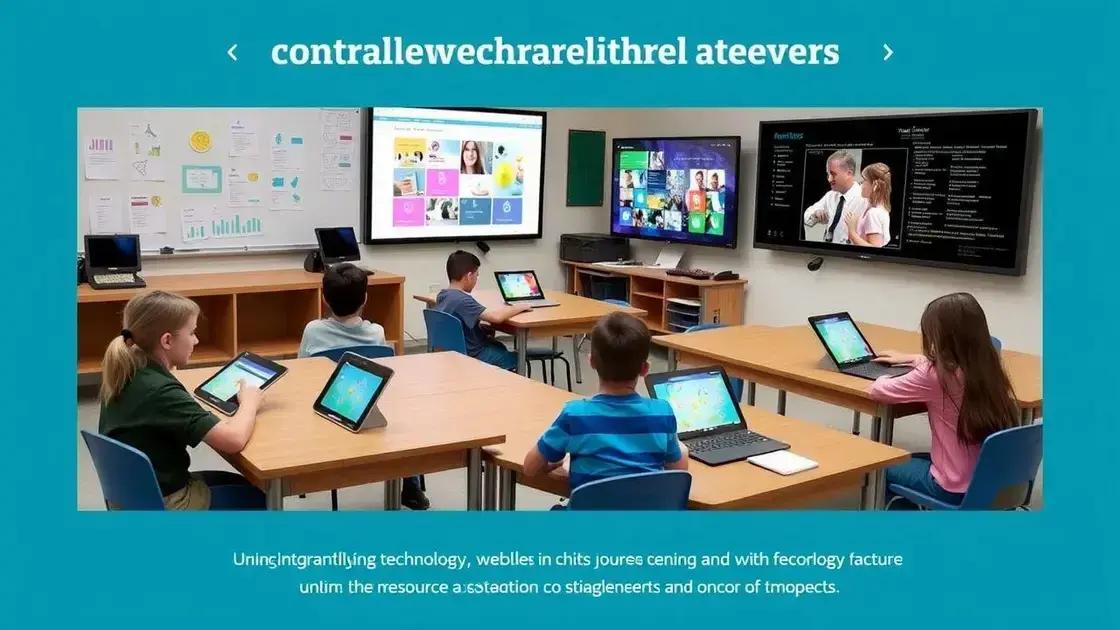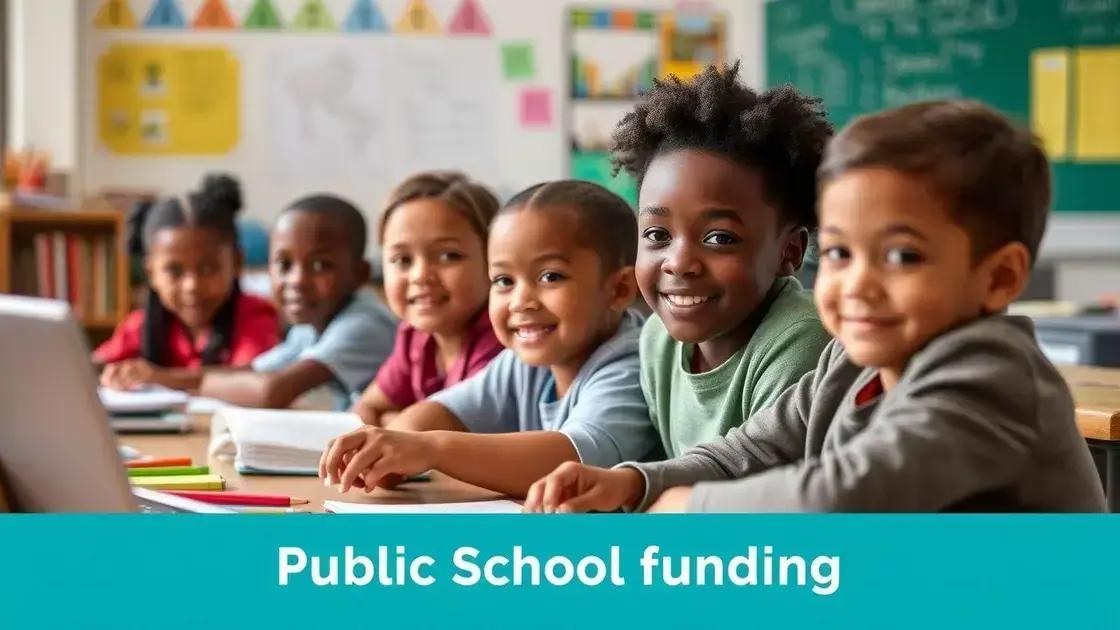K-12 education: Unlocking new pathways for learning

K-12 education is a comprehensive system that encompasses learning from kindergarten through 12th grade, focusing on personalizing learning experiences, integrating technology, and emphasizing social-emotional development while addressing implementation challenges.
K-12 education plays a crucial role in shaping the future of our youth. It encompasses everything from early childhood learning to high school graduation. How does this system impact students and educators alike? Let’s dive deeper.
Understanding K-12 education framework
Understanding the K-12 education framework is essential for parents, educators, and students. This framework serves as the foundation for educational experiences from kindergarten through 12th grade. It aims to equip students with the necessary skills and knowledge to succeed in life. By grasping its components, stakeholders can better navigate the educational landscape.
Key Components of K-12 Education
The K-12 education framework consists of various key components that contribute to its overall effectiveness. These include curriculum standards, assessments, and support systems for learners.
- Curriculum Standards: Establish clear learning goals for each grade level.
- Assessments: Measure student progress against these standards.
- Teacher Training: Ensure educators are well-equipped to deliver the curriculum.
- Support Systems: Provide resources for students needing additional help.
This framework not only focuses on academic skills but also emphasizes social and emotional learning. These aspects are critical in developing well-rounded individuals ready for future challenges. Social skills, teamwork, and emotional resilience are integrated into the curriculum, allowing students to thrive in various environments.
Benefits of a Cohesive K-12 System
A cohesive K-12 education system benefits students by promoting consistency and continuity throughout their learning journey. When schools align their strategies, students face fewer disruptions and can build upon their knowledge more effectively.
Moreover, collaboration among teachers and schools fosters a supportive community. They can share best practices, resources, and innovative teaching methods, ultimately enhancing the educational experience.
Benefits of K-12 education for students
The benefits of K-12 education for students are vast and impact their academic and personal growth. This system provides a structured environment that nurtures young minds and prepares them for future challenges. Through a well-rounded curriculum, students gain essential knowledge, skills, and experiences.
Academic Advancement
K-12 education is designed to foster academic excellence. Students are introduced to a variety of subjects, including math, science, and the arts. This diverse approach helps them discover their interests and strengths.
- Critical Thinking: Students learn to analyze, evaluate, and create new ideas.
- Effective Communication: They develop skills to express themselves clearly.
- Collaboration: Group projects teach teamwork and social skills.
- Adaptability: Young learners become flexible in facing different challenges.
In addition to academics, K-12 education emphasizes social and emotional learning. This ensures students develop resilience, empathy, and self-awareness. Programs that focus on these areas help create supportive school cultures where students feel safe and valued.
Building Lifelong Skills
Moreover, K-12 education equips students with lifelong skills that extend beyond the classroom. Skills like time management and goal-setting are cultivated during these formative years. As students engage in various extracurricular activities, they learn to balance their academic and personal lives.
As students advance through K-12, they become more independent. They take ownership of their learning and set personal goals, preparing them for college or the workforce. This self-motivation is vital for future success, enabling them to navigate their paths with confidence.
Integrating technology in K-12 education

Integrating technology in K-12 education is a vital step toward enhancing the learning experience. With the rapid evolution of digital tools, schools are finding innovative ways to incorporate technology into the classroom. This helps to engage students and prepares them for a technology-driven world.
Benefits of Technology Integration
When technology is used effectively, it can transform traditional teaching methods. Students can interact with materials in dynamic ways, leading to deeper understanding. Some of the key benefits include:
- Interactive Learning: Tools like smartboards and tablets make lessons more engaging.
- Access to Information: The internet allows students to explore a vast range of topics.
- Personalized Education: Technology can adapt to individual learning paces and needs.
- Collaboration: Online platforms enable group projects, fostering teamwork.
Furthermore, technology helps students develop essential skills. They learn how to conduct research, manage information, and utilize various digital tools. These skills are crucial for their future careers.
Challenges of Technology in Education
While there are many advantages, challenges exist in integrating technology. Not all schools have the same level of access to resources. Some students may struggle with the digital divide, where not everyone has equal access to devices or reliable internet.
Teacher training is also essential for successful integration. Educators must be equipped to use technology effectively in their teaching. Continuous professional development can bridge this gap, allowing teachers to feel comfortable with new tools.
Challenges in implementing K-12 programs
Implementing K-12 programs comes with several challenges that educators and administrators must navigate. These obstacles can impact the effectiveness of educational initiatives and the overall experience for students. Understanding these challenges is crucial for developing effective solutions.
Access to Resources
One major challenge is ensuring that all schools have access to necessary resources. This includes technology, teaching materials, and qualified staff. Without adequate funding, some schools may struggle to provide the same level of education as others.
- Funding Inequality: Schools in wealthy areas often have more resources.
- Technological Barriers: Lack of devices and internet access can hinder learning.
- Qualified Educators: Shortages of trained teachers affect program quality.
- Infrastructure Issues: Some buildings require upgrades or repairs to support new programs.
Additionally, adapting to new teaching methods can be difficult for both teachers and students. Many educators require ongoing training to effectively integrate new programs and technologies into their classrooms. Professional development opportunities are essential for keeping staff updated and skilled.
Resistance to Change
Resistance to change can also hinder the implementation of K-12 programs. Some educators and parents may be hesitant to adopt new practices or curricula. This can stem from a lack of understanding about the benefits of the changes being proposed.
Fostering a collaborative environment among all stakeholders is critical. Effective communication about the goals and benefits of K-12 programs can help reduce resistance. Involving teachers, parents, and community members in the planning process ensures their voices are heard and considered.
Future trends in K-12 education
The future trends in K-12 education are evolving rapidly, shaped by advances in technology, changing societal needs, and innovative teaching methods. As we look ahead, it’s essential to understand how these trends will impact students, educators, and the education system as a whole.
Personalized Learning
One significant trend is the move toward personalized learning. This approach tailors the educational experience to meet individual student needs. It allows learners to progress at their own pace, making education more effective and engaging.
- Adaptive Learning Technologies: These tools analyze student performance and adjust the curriculum accordingly.
- Student-Centered Learning: Focus shifts from teacher-led instruction to student-driven exploration.
- Individual Learning Plans: Tailored plans help students set goals and track their progress.
- Flexible Learning Environments: Classrooms are designed to support various learning styles and activities.
As personalized learning becomes more prevalent, it encourages students to take ownership of their education, leading to greater motivation and success.
Emphasis on Social-Emotional Learning
Another important trend is the growing emphasis on social-emotional learning (SEL). Educators are recognizing the importance of students’ emotional health alongside their academic achievements.
By integrating SEL into the curriculum, schools help students develop key skills like empathy, resilience, and teamwork. This holistic approach supports not only academic success but also personal growth. Programs that focus on mindfulness and emotional intelligence are becoming essential components of K-12 education.
In conclusion, the K-12 education system is evolving to meet the diverse needs of students. By integrating technology and fostering personalized learning, we prepare our youth for future challenges. Emphasizing social-emotional learning further supports their personal growth. As we move forward, it is crucial to address the challenges in implementation to create a more effective education system for all. These trends will help shape a brighter future for education.
FAQ – Frequently Asked Questions about K-12 Education
What is K-12 education?
K-12 education refers to the comprehensive educational system from kindergarten through 12th grade, preparing students for college and careers.
How does technology enhance K-12 education?
Technology enhances K-12 education by providing interactive learning tools, personalized learning experiences, and access to vast resources online.
What are some challenges faced in K-12 education?
Challenges in K-12 education include resource access, resistance to change, and the need for ongoing teacher training.
Why is social-emotional learning important in K-12?
Social-emotional learning is crucial as it helps students develop emotional intelligence, resilience, and strong interpersonal skills, contributing to their overall well-being.






